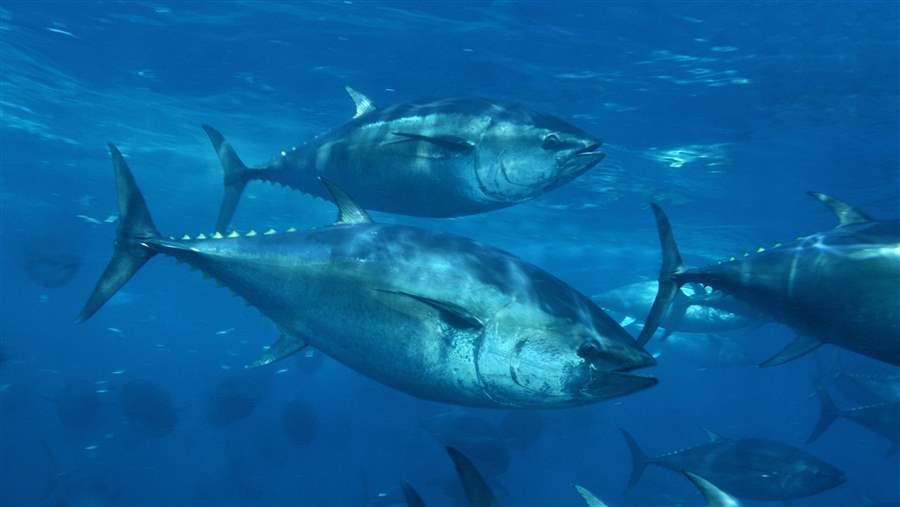Illegal Fishing Costs Pacific Islands Millions Annually in Lost Tuna Revenue
New reports highlight expensive threat to regions’ fisheries
 Richard Herrmann, SeaPics.com
Richard Herrmann, SeaPics.comThe end value of Pacific tuna surpassed $17 billion in both 2012 and 2014. When accounting for the full price of canned tuna, these values were more than $22 billion in both years.
For many, the Pacific Ocean is synonymous with tuna. Not only do these fish populations hold the key to long-term economic and food security in the region, but the connections between tuna and various communities are also part of island culture. Each year on May 2, Pacific islands celebrate World Tuna Day to recognize the critical role these dynamic fish play in the health of marine ecosystems and the global marketplace. This year, as communities gather to mark the day, the financial costs of illegal, unreported, and unregulated (IUU) fishing are more clearly coming into focus.
A new Pew report estimates that tuna fishing around the world generates more than US$42 billion in revenue annually and finds that the total catch in the Pacific has the highest value. The report, Netting Billions: A Global Valuation of Tuna, concludes that commercially landed Pacific tuna “generated dock values of more than $6.5 billion in 2012 and $5 billion in 2014. The end value of Pacific tuna surpassed $17 billion in both years. When accounting for the full price of canned tuna, these values were more than $22 billion in both years.
These estimates, when compared with those on the value of fish caught illicitly in another recently released study, put the region’s problem with illegal fishing into perspective.
The waters in the western and central Pacific are among the richest when it comes to the value of tuna catch. To ensure the long-term sustainability of this important fish stock, members of the Pacific Islands Forum Fisheries Agency (FFA) have developed and implemented a robust framework of monitoring, control, and surveillance. FFA members take on this mission with support from the agency-managed Regional Fisheries Surveillance Center. These efforts demonstrate the ongoing commitment by leaders in the region to fight IUU fishing and other fisheries crimes.
A recent report prepared for the FFA by the Marine Resources Assessment Group (MRAG) Asia Pacific highlights the prevalence of IUU fishing and the threat it poses in the these waters. The report also seeks to quantify the nature and extent of IUU fishing in Pacific tuna fisheries.
The study estimates the total value of illegally harvested or transshipped tuna in the region at about $616.11 million a year. That equates to more than 12 percent of the $5 billion that the Pew report estimates was paid to fishermen for their tuna catches in the region in 2014 and represents a significant loss to fishing nations with limited resources and jobs. Importantly, the study found that fleets licensed to operate in this region accounted for over 95 percent of the total volume and value of IUU activity.
The estimated volume of IUU product was found to be highest in the purse seine fishery, which accounted for 70 percent of the illegal catch. Reporting violations and the use of illegal fish aggregating devices drove most of that volume. Longline fishing accounted for the remaining 30 percent, primarily because of misreporting and illegal transshipping.
Although this latest assessment of the cost of IUU fishing activity is significantly lower than previous ones, researchers used a new approach that factored in best estimates in conjunction with minimum and maximum range values. To conduct the study, the authors developed a framework for quantifying the value of the lost catch and created a basic model that can be updated as risks change or more accurate data become available. Improved methods for assessing IUU fishing give fisheries managers better tools to gauge the potential damages suffered by coastal states; develop ways to improve the effectiveness of monitoring, control, and surveillance; and address inaccuracies in stock assessments.
The results of the IUU fishing study, however, indicate continued uncertainty when it comes to assessing the amount of activity and key risks. Such quantification is not always straightforward. Additional measures must be sought to improve monitoring and traceability throughout the supply chain, strengthen incentives to foster compliance, and build up deterrents to noncompliance. The study suggested that work remains to be done, particularly regarding efforts to strengthen reporting and catch-based management measures in the longline fishery. It is only through adequate global ocean governance, with science-based models that take into account changes in fishing methods and habits, that we can create a stable future for our oceans.
So, whether it is skipjack, albacore, yellowfin, or bluefin, there is no doubt that tuna is a critically valued resource for Pacific island economies. It becomes imperative, then, that governments around the world take action to properly police and enforce the rules for fishing in these waters.
The depletion of tuna stocks—whether through IUU fishing, overfishing, or a combination of the two—puts the health of the ocean at risk and jeopardizes the long-term economic security of island nations and the people whose lives are so closely linked to these waters.
Tony Long directs The Pew Charitable Trusts’ ending illegal fishing project, and Amanda Nickson directs its global tuna conservation project.











